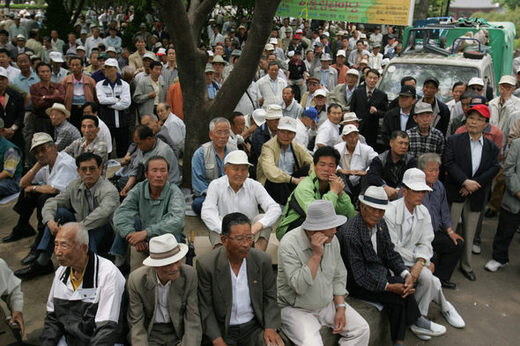hankyoreh
Links to other country sites 다른 나라 사이트 링크
Korea expected to become ’aged society’ in 2013

According to the National Statistical Office, the nation is aging rapidly, with a low birthrate yielding statistics rarely seen in advanced nations.
Results of a survey released by the office on May 25 showed that the population of those aged 65 or older increased by 33 percent to about 4.36 million, only five years after it first exceeded 3 million. At this pace, Korean society is expected to become a so-called "aged society" by 2013, only 13 years after its designation as an "aging society" in 2000. In an aging society, people aged 65 or older make up over 7 percent of the population, while in an aged society this number exceeds 14 percent. It took France 115 years and the U.S. 72 years to go from an ageing society to an aged society; Japan took 24 years for this change.
The rapid pace of Korea’s aging is due to its low birthrate, about 1.16 births per woman aged 15 to 49. The population under 15 years old decreased by 6.8 percent during the past five years. In about 15 years, when the baby boomer generation is included in the population aged 65 or older, the pace of aging will accelerate. Experts predict economic and social problems to become serious. Until now, there have been seven adults per two children and one aged person. However, from now on, statistics predict, those who are working will decrease, while those who receive support from others will increase.
Mun Hye-jin, an official of People’s Solidarity for Participatory Democracy, pointed out, "We can’t stop the aging of the society, so we must prepare countermeasures against the low birthrate. For this matter, it is insufficient to offer aid for childbirth or childcare. We should conduct a wholescale reform to expand social services such as education and housing."
For those under five years old, the ratio of the male population was 108.1 for every 100 women in 2005. This figure is evening up, as it stood at 113.4 male children per 100 female children in 1995 and 110.2 in 2000.
Due to longer life expectancy for women, in particular, the female population exceeded the male population for the first time since 1945. There were roughly 100.7 men for every 100 women in 2000, but the ratio was about 99.5 men per 100 women in 2005.
Among the population aged 15 or older, the number of people who divorced was 3.0 percent, up 1.9 percent from the divorce rate of 1.1 percent in 2000. In the meantime, the number of married people decreased 1.3 percent from 2000, while the number of singles increased 14.9 percent among those in their late 20s and 10.7 percent among those in their early 30s.
The overall median age of Koreans was 35 years, up 3 years from the median figure in 2000.
The National Statistical Office compiled data on families separated by the division of the Korean Peninsula for the first time on the request of the Ministry of Unification. 1.5 percent of the population, or 716,000 people, said they have family members in North Korea. Among them, 6.7 percent were separated from their parents in the North and another 10.6 percent left their siblings in the communist nation.
Editorial・opinion
![[Column] Has Korea, too, crossed the Rubicon on China? [Column] Has Korea, too, crossed the Rubicon on China?](https://flexible.img.hani.co.kr/flexible/normal/500/300/imgdb/original/2024/0419/9317135153409185.jpg) [Column] Has Korea, too, crossed the Rubicon on China?
[Column] Has Korea, too, crossed the Rubicon on China?![[Correspondent’s column] In Japan’s alliance with US, echoes of its past alliances with UK [Correspondent’s column] In Japan’s alliance with US, echoes of its past alliances with UK](https://flexible.img.hani.co.kr/flexible/normal/500/300/imgdb/original/2024/0419/2317135166563519.jpg) [Correspondent’s column] In Japan’s alliance with US, echoes of its past alliances with UK
[Correspondent’s column] In Japan’s alliance with US, echoes of its past alliances with UK- [Editorial] Does Yoon think the Korean public is wrong?
- [Editorial] As it bolsters its alliance with US, Japan must be accountable for past
- [Guest essay] Amending the Constitution is Yoon’s key to leaving office in public’s good graces
- [Editorial] 10 years on, lessons of Sewol tragedy must never be forgotten
- [Column] A death blow to Korea’s prosecutor politics
- [Correspondent’s column] The US and the end of Japanese pacifism
- [Guest essay] How Korea turned its trainee doctors into monsters
- [Guest essay] As someone who helped forge Seoul-Moscow ties, their status today troubles me
Most viewed articles
- 1[Column] The clock is ticking for Korea’s first lady
- 2After 2 months of delayed, denied medical care, Koreans worry worst may be yet to come
- 3Hong Se-hwa, voice for tolerance whose memoir of exile touched a chord, dies at 76
- 4Samsung barricades office as unionized workers strike for better conditions
- 5[Column] Has Korea, too, crossed the Rubicon on China?
- 6US overtakes China as Korea’s top export market, prompting trade sanction jitters
- 7[Editorial] As it bolsters its alliance with US, Japan must be accountable for past
- 8[Correspondent’s column] In Japan’s alliance with US, echoes of its past alliances with UK
- 9All eyes on Xiaomi after it pulls off EV that Apple couldn’t
- 10[Guest essay] How Korea turned its trainee doctors into monsters